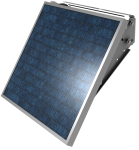
Resources and Links
Product Brochures
FAQs for
Number of FAQs related to Power Supplies: 3
Expand AllCollapse All
-
When a battery won’t charge above approximately 10 or 8 V, it has a bad cell. The battery should be replaced.
A 12 V lead-acid battery is six cells in series; the chemistry provides a little over 2 V per cell.
-
A power budget for the period in question should be calculated first before selecting any type of power supply. For example, a CR1000 in quiescent mode consumes approximately 0.7 mA. Quiescent current means the datalogger is not making measurements and is not communicating with anything. This current consumption during the year also does NOT include any current consumed by sensors or communications devices, which should be part of the calculation. This equates to 0.0168 A per day or 6.132 A per year.
Typically, a 20% buffer of reserve capacity should be kept in any battery scheme, which equals approximately 7.7 A per year. In applications where the temperature is below freezing, Campbell Scientific recommends increasing the reserve current to 30 to 40%.
Reserving current in this amount is not possible with a BPALK 12-V Alkaline Battery Pack or a 7 Ah battery such as what is used with a PS100 Rechargeable Power Supply. More suitable choices would be the BP12 12 Ah Battery Pack, BP24 24 Ah Battery Pack, PS84 84 Ah Power Supply, BP84 84 Ah Battery Pack, or a user-supplied deep-cycle battery. Batteries can be swapped out and charged at the end of each year of use.
-
Estimating the power consumption of a system can help with selecting the best power supply option. The system power consumption can be approximated by calculating the average current required by the datalogger, sensors, and peripheral equipment. This average current drain is primarily determined by the percentage of time spent in an active versus quiescent state, which can be approximated from the scan rate and program length of the datalogger.
For more information, and guidance through the calculations, see the "Power Supplies Overview" brochure or the "Power Supplies" application note.



